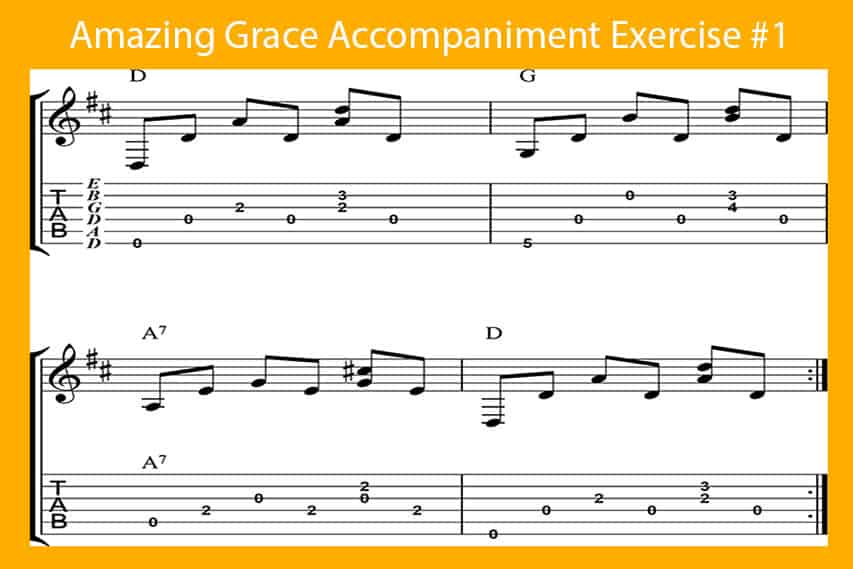
Time for some fun.
In the previous lesson I taught a basic easy guitar version of Amazing Grace with the chords. I also showed you how to use the capo to adjust to whoever is singing the song. By popular request I’ve decided to create this lesson with two Fingerstyle versions.
The first version uses a fingerpicking pattern to accompany yourself or others while singing the melody. Once you learn the fingerpicking pattern and how to finger the chords this is a fairly easy version.
The second version is a more advanced one. I've included a simplified version of Amazing Grace as a Fingerstyle guitar solo with the melody and chords played together. Of course “simplified” is a relative term. If you're new to Fingerstyle guitar this may not seem simple.
Drop D Guitar Tuning
Both versions use what is called a Drop D Tuning.
To tune your guitar to Drop D Tuning simply tune the low E string down to add the note. That means one step in the musical scale. The notes now become D(low), A, D, G, B and E (high). The easiest way to do this is to just use a guitar tuner.
Why Would I Want To Do The Drop D?
The main reason is that this tuning allows the D chord to have a nice deep bass note. When I'm playing an instrumental it creates an extended range of the notes and a nice texture to the song.
Another benefit is that it forces you to finger the chord a little different. The effect is to create chord voicings the sound a little different than they do in the regular tuning. It's kinda like cooking a standard dish with a little different combination of spices. It can make a standard chord progression sound more interesting… even though it's not terribly different.
Usually I would use the Drop D Tuning for an instrumental song. That’s where the different texture would be most noticeable. Check out my song “Lotus In The Moonlight” on my CD Beauty And Fire to get an idea of what this can really sound like. In this case I've used it also in the accompaniment to give you a chance to get accustomed to the chord forms and the sound before trying the instrumental arrangement.
I'd encourage you to play around with this tuning and have fun with it. You'll likely find it a welcome addition to the options you have when playing guitar. Fortunately it's a fairly easy alternate guitar tuning, especially compared to the ones where you change the tuning of several of the strings. This means it'll be easy to tune your guitar back to standard tuning as well.
Amazing Grace Fingerpicking Accompaniment
- First tune your guitar to the Drop D Tuning. Tune that low E note down to a D. If you'd like some extra help I've created a short Drop D Tuning video here to demonstrate how to do that.
- Then go ahead and try out the chord forms. I think you'll find the G chord the most different than the one you’re accustomed to playing. Practice moving from one chord to another just like you would if you're learning new chords.
- The next step is to practice the fingerpicking pattern. You can start with any chord, but I'll suggest starting with the D chord to have some fun with that low bass note. The pattern is thumb, first finger, second finger, first finger, second and third finger together, and finally back to the first finger. You'll find that not only have I demonstrated this on the video but I've written it out using both notes and tablature on the cheat sheet that you can download below.
- Once you feel reasonably comfortable you can try the pattern with the other chords as well. I'm not talking about perfect… You'll improve as you practice with other chords and with the song. Of course you'll have to use your judgment, but one way to think about it is try to play the pattern twice through slowly without stopping before moving to the next chord. This is just a suggestion and there's no hard and fast rule.
- Now play Exercise #1 that you can find on the cheatsheet (download below). This exercise is designed to help you practice changing from one chord to another while doing the fingerpicking pattern. It's important to go slow at first and choose accuracy over speed. As time goes on you can pick up the speed. I like to use a metronome once I can do the exercise very slowly so I can measure how well I'm doing and at the same time improve my timing.
- Now you're ready to apply both the pattern and the chord changes to playing the song. Practice playing the chord changes without singing. Once you can get through the whole song slowly you can try singing along as well.

Resources:
Download the sheet here:
Amazing Grace Fingerstyle Guitar Cheatsheet (with Solo Guitar Version)
Here's the lesson with chords and strumming:

Hi Tomas,
This is what I’ve been looking for. Count me in on your finger picking course when you are finished with it.
Ron
Thanks Ron. You got it. – Tomas
This is excellent Thomas. You are indeed a brilliant teacher.I recommend you to all friends.
Thanks Gerard. -Tomas
Thank You Thomas Your lectures have been very helpful
You are very welcome Hal. – Tomas